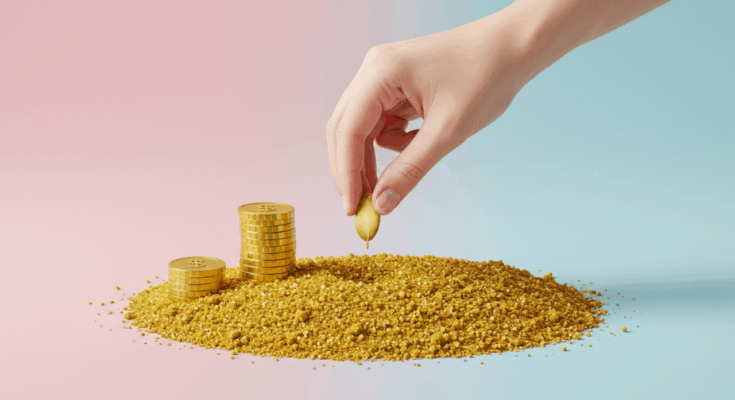Financial freedom isn’t a distant dream reserved for lottery winners or tech moguls—it’s a reality built through tiny, consistent actions that compound over time. Think of it as planting seeds in a garden: Each micro-step nurtures growth, eventually yielding a harvest of independence where work becomes optional, and money worries fade. In a society bombarded with overnight success stories, the truth is that sustainable wealth comes from incremental progress. This article breaks down the micro-steps to financial freedom, offering practical, bite-sized strategies that anyone can implement, regardless of starting point. We’ll address common hurdles like “Where do I begin if I’m in debt?” and “How do small changes add up?” with clear, actionable advice. By focusing on these steps, you’ll gain momentum, build habits, and create a path to a life where finances empower rather than constrain you.
Defining Financial Freedom for You
What Financial Freedom Really Means
Financial freedom means different things to different people—it’s not just about retiring early with millions. For some, it’s quitting a soul-crushing job to pursue passions; for others, it’s covering bills without stress or funding family adventures. At its core, it’s when your passive income or savings cover living expenses, freeing you from the paycheck treadmill.
To personalize it, calculate your “freedom number”: Multiply annual expenses by 25 (based on the 4% safe withdrawal rule from retirement studies). If you spend $40,000 yearly, aim for $1 million in investments. This micro-step—running the numbers—demystifies the goal, making it tangible rather than overwhelming.

Assessing Your Starting Point
Before taking steps, map your current terrain. Track net worth: List assets (savings, home equity) minus liabilities (debts). Use a free spreadsheet or app like Personal Capital for this. Next, log income and expenses for one month—no judgments, just data.
This reveals leaks: That $5 daily snack might total $1,800 yearly. Common question: “What if my net worth is negative?” It’s okay—many start there. Focus on progress, not perfection; even a $100 improvement monthly shifts the narrative.
Cultivating a Freedom Mindset
Shifting from Scarcity to Abundance
Mindset is the soil for your financial garden. A scarcity view—”There’s never enough”—leads to hoarding or impulse buys. Counter it with daily micro-affirmations: “I control my money choices.” Read one finance article weekly to build knowledge confidence.
Practice gratitude: Note three things money enables, like a warm meal. This rewires thinking, reducing fear-based decisions. Actionable tip: Set a phone reminder for a two-minute mindset check-in, asking “How can I make today financially smarter?”
Embracing Delayed Gratification
Micro-steps thrive on patience. Implement the “24-hour rule” for non-essentials: Wait a day before buying. This curbs impulses, saving hundreds. Track “wins”—money not spent—and redirect to a freedom fund.
Studies show delayed gratification correlates with wealth-building. Start small: Skip one coffee weekly, banking $20 monthly. Over a year, that’s $240 plus interest, illustrating compounding’s power.
Mastering the Basics: Tracking and Budgeting
Creating a Simple Tracking System
Knowledge is power—start tracking every transaction. Use a notebook or app like Mint to categorize: Needs (50%), wants (30%), savings/debt (20%). This micro-habit takes five minutes daily but uncovers patterns.
For beginners: Focus on one category first, like food, to avoid overload. Question answered: “How do I track without apps?” Pen and paper works—list date, amount, category. Review weekly to spot trends, like weekend overspending.
Building a Flexible Budget
Budgets aren’t rigid cages; they’re freedom frameworks. Allocate based on priorities: If travel dreams drive you, cut subscriptions. Automate bills to prevent late fees, saving $50-100 yearly.
Micro-step: Adjust one line item monthly. If groceries overrun, meal plan Sundays—prep three meals, slashing costs 30%. This builds discipline without deprivation, answering “How do I budget on irregular income?” Average three months’ earnings for a baseline.
Small Savings Habits That Compound
Automating Your Savings
The easiest micro-step: Automate. Set 5-10% of paycheck to transfer to savings on payday—”pay yourself first.” High-yield accounts (4-5% APY) amplify this.
Start tiny: $10 weekly. In a year, $520 plus interest. Round-up apps like Acorns invest change from purchases, turning pennies into portfolios. This habit answers “How do I save when broke?” Begin with whatever you can; consistency trumps amount.
Cutting Costs Creatively
Silent savings add up. Negotiate bills annually—call providers; many drop 10-20%. Switch to generic brands, saving 25% on groceries. Micro-challenge: “No-spend days” twice weekly, using what’s home.
For housing, the biggest expense: Roommate or downsize if feasible. Energy audits cut utilities 10-20%—simple fixes like LED bulbs pay off quickly. These steps build a cushion, essential for freedom.
Tackling Debt with Precision
Prioritizing and Paying Down Debt
Debt blocks freedom; micro-steps dismantle it. List debts by interest rate. Use the avalanche method: Minimums on all, extra on highest rate. Snowball alternative: Smallest first for psychological wins.
Action: Pay $25 extra monthly on a card. At 20% interest, it shaves months off. Consolidate if rates allow—balance transfers with 0% intro periods. Avoid new debt by using cash for wants.
Building an Emergency Buffer
Before aggressive debt payoff, stash $1,000 for emergencies—micro-goal: $100 monthly. This prevents borrowing for surprises. Once set, expand to 3-6 months’ expenses.
Tip: Separate account, no debit card. This safety net answers “What if life happens?” It keeps momentum, turning setbacks into blips.
Investing for Future Growth
Starting Small with Investments
Investing isn’t for the wealthy—micro-steps make it accessible. Open a brokerage; invest $50 monthly in index funds tracking the market (7-10% historical returns).
Educate via free resources: Podcasts like “ChooseFI.” Diversify: Stocks for growth, bonds for stability. Roth IRA for tax perks if eligible. Compounding magic: $100 monthly at 8% grows to $150,000 in 30 years.
Understanding Risk and Patience
Beginners fear losses—start conservative. Dollar-cost averaging: Invest fixed amounts regularly, buying more shares low. Rebalance yearly.
Question: “What if the market crashes?” History shows recovery; stay invested. Micro-habit: Review portfolio quarterly, not daily, to avoid emotional trades.
Boosting Income Incrementally
Side Hustles Without Burnout
Freedom accelerates with extra income. Micro-start: One hour weekly on skills like freelancing (writing, graphic design via Upwork). Aim for $100 monthly initially.
Passive ideas: Sell digital downloads (printables) or rent gear. Upskill free via YouTube—learn coding basics for gigs. This diversifies, answering “How do I earn more without quitting?”
Negotiating and Career Growth
Ask for raises: Prep with achievements; 5-10% bumps compound. Micro-step: Update LinkedIn weekly, network one contact monthly. Switch jobs every 2-3 years for 10-20% increases, per data.
Long-Term Strategies and Maintenance
Planning for Milestones
Map big goals: Retirement, home, education. Use calculators to set micro-targets—$200 monthly for a $50,000 down payment in 10 years.
Estate planning: Basic will via online tools. Health savings accounts for medical freedom. Review annually, adjusting for life changes.
Staying Motivated and Adapting
Track wins: Monthly net worth updates. Join communities for accountability. If plateaus hit, tweak one step—like increasing savings 1%.
Freedom is iterative; micro-steps ensure steady progress, building resilience against economic shifts.
FAQ
What if I have no money to start investing?
Begin with education and savings automation—even $5 weekly. Focus on debt first; freed cash flows to investments.
How do micro-steps differ from big leaps?
They build sustainable habits without overwhelm. Big leaps risk burnout; small ones compound reliably.
Can I achieve financial freedom on a low salary?
Yes—emphasize cost-cutting and income growth. Many do it through frugality and side hustles, not high earnings.
What tools do I need to get started?
Free ones: Spreadsheets for tracking, library books for learning, apps for automation. No fancy software required.
How long until I see results?
Noticeable in 6-12 months with consistency—reduced stress, growing savings. Full freedom? 10-20 years, depending on starting point.



